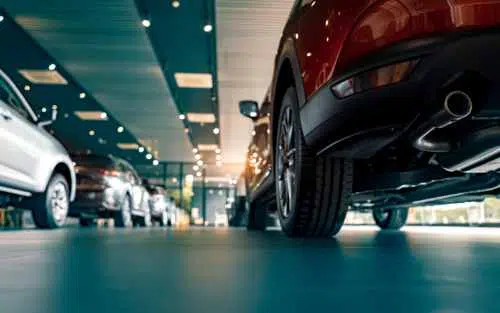Nearly 4,000 car dealerships are begging Joe Biden to pull back on the “unrealistic” EV mandates. The EVs are piling up on lots and carmakers are losing billions of dollars.
A group of 3,882 dealers sent President Biden a letter begging him to lighten future EV sales requirements.
EVs are not ready for the average buyer and may not be for some time. It’s amazing that Biden’s advisors didn’t see that before demanding the regulations.

Car Scoops Report
In the letter dated November 28th, 2023, dealers say that while BEVs are ideal for many people, “demand today is not keeping up with the large influx of BEVs arriving at our dealerships.” They go on to say that the regulations are unrealistic based on current and forecasted customer demand. At one point, the letter even talks about how nobody knows more than them about car customers.
Major issues at hand, in the eyes of the dealers at least, include charging infrastructure. Customers who don’t have a way to charge at home have to rely on the public network, which isn’t exactly amazing. In addition, they say that customers are “concerned about BEVs being unaffordable.”
Autoblog Report
“No government agency, no think tank, and no polling firm knows more about the automobile customer than us. We talk to customers every day. As retail automotive dealerships, we are agnostic as to what we sell. Our business is to provide customers with vehicles that meet the needs of their budgets and lifestyles,” the letter states. What they’ve collectively found is that “the majority of customers” don’t want an EV.
The dealers provide several explanations. One is that customers are concerned about the price of electric cars, which cost significantly more than comparable gasoline-powered models. For context, the 2024 Hyundai Kona carries a base price of $25,435 including destination, while the 2023 Kona Electric starts at $34,885. Charging remains a problem as well:
Many motorists don’t have a garage, don’t have easy access to public charging stations, or both, according to the letter. Driving range is an issue, too, especially in hot and/or cold climates, and a lot of drivers find filling up a fuel tank in a few minutes far more convenient than waiting for a battery pack to charge. As for truck shoppers, dealers argue that they’re “put off by the dramatic loss of range while towing” — Ford’s F-150 Lightning loses about 25% of its range when towing.
Last but definitely not least, the letter points out that “many people just want to make their own choice about what vehicle is right for them.”
Legal Insurrection
EVs are too expensive to buy, run, and maintain under “Bidenomics.”
EV inventories have increased by 506% from a year ago, according to CarGurus’ October report, released this month. EVs sit on the market for an average of 82 days versus 64 days for gas-powered vehicles, it said. Automakers like Ford and GM are cutting production. Toyota was smart enough not to go whole hog.
“While consumers still have plenty of concerns surrounding an EV’s battery range, price remains the higher priority when purchasing an EV,” said Julia Martinez, an energy & auto analyst at business intelligence company Morning Consult, in a report.
Car dealerships are begging Biden for help, as they want him to use his pen and phone to undo the ridiculous EV mandates that have popped up across the nation…thanks to green energy pseudoscience and climate cultists.
Opinion
The entire fiasco was ill-conceived, and electrifying everything links us inextricably to China, which controls the market for minerals. The West has some vague idea of acquiring minerals without using China but no real plan. Anyone who does supply them that is not China is raising their prices.
Biden won’t respond and won’t do a thing if past is prologue.


Products made from Petroleum (144 of 6,000) items. Solvents Diesel fuel Motor Oil Bearing Grease Ink Floor Wax Ballpoint Pens Football Cleats Upholstery Sweaters Boats Insecticides Bicycle Tires Sports Car Bodies Nail Polish Fishing lures Dresses Tires Golf Bags Perfumes Cassettes Dishwasher parts Tool Boxes Shoe Polish Motorcycle Helmet Caulking Petroleum Jelly Transparent Tape CD Player Faucet Washers Antiseptics Clothesline Curtains… Read more »
Yes and most people do not know that 99% of plastic are made from petrol. Almost everything we use is made, at least in part, with plastic would people buy a cell phone, a tablet or a laptop made of wood? or what if the inside of their car was made of wood and metal would they like that ?… Read more »
So we can save the environment and get rid of fossil fuels by driving electric cars, right? Read this. SUBJECT: BATTERIES Tesla said it best when they called it an Energy Storage System. That’s important.They do not make electricity– they store electricity produced elsewhere, primarily by coal, uranium, natural gas-powered plants, diesel-fueled generators or minerals. So, to say an Electric… Read more »
Neat! I would add that the EV battery must be considered as an exotic fuel (not just a tank) since it’s gradually consumed–adding to the cost per mile if one wants to calculate expenses from that perspective.
“Biden won’t respond and won’t do a thing if past is prologue.”
When was the last time senile Biden did anything? When he scared away that bad dude “Corn Pop”?
In the Brave new world that Biden seems to dream about, he would simply get a quick needle, and his body recycled into artificial meat process.
I notice that that senile, little girl fondling babbling old fool Joe hasn’t challenged anyone to do push-ups lately.